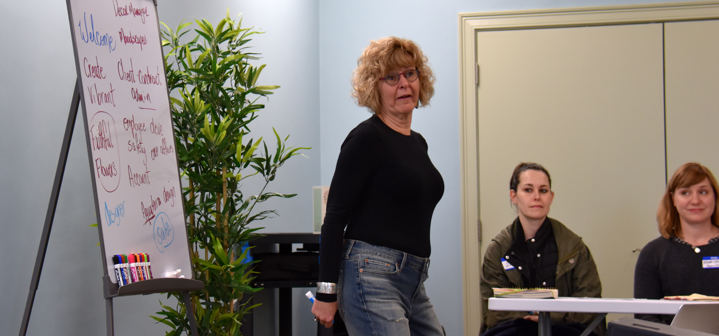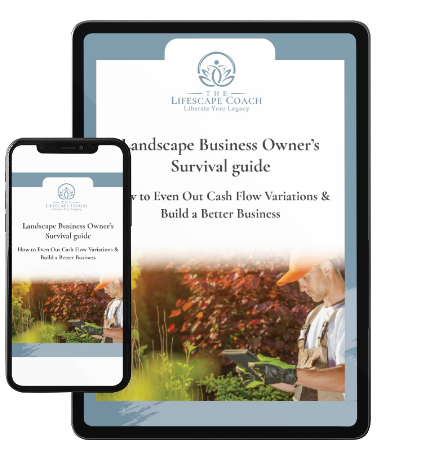Five Tools for Cultivating a Compassionate Culture in Your Business
As a landscape business owner with over 30 years in the business, I know that our employees are more important than any truck, piece of equipment, or account. Without them, we cannot hope to reach our business growth goals.
To that end, I decided to start 2018 off with a management team training focus in the hopes that with their development would come the next wave of success for The Garden Continuum.
Ten of us have been working since the opening of the season to define our internal culture. We started with a managers luncheon to introduce the idea of culture-building to the team. We then spent three weeks talking about the book “Braving the Wilderness” by Brene Brown, which introduces the concept of “True Belonging” as the primary concern of all people.
On May 1st we held a day-long training session about Cultivating a Compassionate Culture with Kim Barthel, a world-renowned speaker, trainer, and occupational therapist who specializes in teaching about complex behaviors, corporate wellness, sensory processing, and mental health.
We opened this event to other landscape companies as well. It was a great success, and everyone left raving about Kim and the content shared. The feedback was so positive that we hope to bring her back to share her more of her wisdom with us, our partner businesses, and blog community. If you want more of Kim's wisdom, you can check out her book, "Conversations with a Rattlesnake", written with Theo Fleury, Canadian Hockey legend, about trauma and healing. Their work is being applied globally!
 Kim Barthel had the room captivated with her definitions of compassion and how that relates to our businesses!
Kim Barthel had the room captivated with her definitions of compassion and how that relates to our businesses!
What makes compassion in your business culture so important?
Owners and managers often struggle with how to build sustainable and productive working teams in their businesses. There’s confusion about how to find the right people, train them, and keep them for the long haul. Businesses suffer from the revolving door of hope and disappointment in staff which then drives a culture of fear and suspicion where the only loyalty is to money, and even that falls short.
So how do we grow beyond this struggle culture?
Organizational development starts with the structure and systems that you put in place for your business, but that’s only half the work. The other piece of the puzzle is the people you plug into that culture.
Without clear business structure, the people are going to feel lost.
Without the right people, the business structure is going to be weak.
Together the two make a powerful tool for business success that isn’t only about the bottom line. It’s also about the satisfaction and joy that can come from being a part of a high functioning team of people all working toward the same results with extraordinary humanity.
Before you check out on this topic because you feel it’s too woo-woo for you - consider these questions:
- If you could go to bed every night feeling that you did your best at work and everyone else also brought their best to their work, would you sleep better?
- If you were able to wake up every morning and feel confident about going to work - even if you knew it was going to be a challenging work day - would you be calmer and maybe even more inspired as you got ready to take on the day?
Compassion, as a team building tool, will offer you peace of mind every time!
Human beings were built to live and work in a community - it is a biological fact.
What do you think could be going wrong in your organization that derails this natural function of cooperation and safety that identifies us as a social species?
The answer is simple, we are - most of us - afraid.
We are working from scarcity, suspicion, and entitlement that does not serve us. This is true for owners, managers, and production level workers and it is the undoing of our success potential both personally as well as collectively.
While there is no way that I can solve this substantial social struggle with one blog post, I am going to share a small piece of what we learned in our spring training so far.
Below you will find the five variables you can tend in your business that will help you to move away from a struggling culture toward one of more ease, comfort, and ultimate satisfaction for you and the people that work for and with you.
These concepts may come across as simplistic, but don’t be fooled, they take practice to adopt and weave into a daily practice of compassionate culture. Go easy on yourself and allow the concepts to sink in through reading and trying them one by one. In time, you may be practicing all five and feeling a shift in you and your organization. I am amazed at the change in ours.

Five Tools for Cultivating a Compassionate Culture in Your Business
- Practice non-attachment
- Don't wait until there is a crisis
- Consistency is critical
- Team is paramount
- An example of how to work this into your company
1. Practice Non-Attachment
One of the big tripping points for owners and managers is a deep desire to have things done “their way” because they believe they are right and know the best way to do the work. The thing is, probably 75% of the time that’s the truth. However, we can also get entrenched and closed off to new approaches to finding the best solutions. I’m saying “WE” here because as an owner I have fallen into this trap repeatedly.
As the world of communication and service delivery changes, it’s critical that we open up to the NEW market and all its variables. This is never more evident than when we are faced with new employees who have new ideas and a bright eagerness to make a difference.
Learning how to listen, consider, and engage in the potential for positive change will be the difference between running a status quo, stale business and developing a vibrant business of possibility and innovation.
Now you may be saying to yourself, “Geez, my business is fine the way it is...why change it when it’s working?” I get it...for you...but if you are planning to grow, if you are planning to hire, if you are planning to encourage others to take on management and leadership, you will never fully reach that goal by refusing to let go.
Non-Attachment isn’t “giving up” or “giving away” your ideals, your ways, or your beliefs. It is instead an opening to options and a welcoming of new approaches that will potentially meet your goals faster, more successfully and with more staying power.
2. Don’t Wait Until There’s A Crisis
Small business is plagued with experiences of “putting out fires.” Most of that has to do with having only one person at the helm. It also has to do with not having a structure in the business. The result is a reliance on reacting to what happened the day before or just moments before as the central management and leadership tool. Believe me, I’m still working on building myself out of the daily equation!
Planning and training are elements of business that get very little, if any, time investment. The excuse being, we have no time for that, we have to get the job done. I get it, I’ve been there. And still today, especially in the springtime, I find moments when I realize I didn’t plan well and I’m the tail waggin’ the dog all over again. The difference for me now is that I know exactly why I’m suffering. I can see with laser clarity why I’m in struggle...I didn’t plan well...I didn’t train my team on that one thing they needed to get the job done!
The other difference, I don’t get “angry” like before. I see it and say, hmm, I dropped the ball on that one. I apologize to my team for not leading with clarity and for not providing the training. I do my best to catch them up and clear things up. AND, I think of how I can put something in place to ensure that issue doesn’t come up again. Little by little, we are building a training and planning culture that keeps us working together to avoid crisis.
The team is encouraged to speak up when they feel I’m sending them out to the wolves without proper protection. I am open to hearing their request for help in advance of crisis and then meet that need with planning and/or training. This is a collective effort. It is impossible to know what your team doesn’t know if they don’t speak up. Make it safe for them to ask for help. One way you do that is to ask them for help. They will see that you’re cool with this team dynamic.
And when a crisis does occur - and it will - be kind with your response. My experience is that 9 times out of 10 people are trying hard. And when they are not...when the crisis is a wanton and flagrant misalignment of values or behaviors, it’s time to be the leader and let that person go.
Reward & Move On
One interesting behavior I often see in the landscape industry is a stinginess around approval and appreciation. I’m not sure why that is or where it comes from, but it’s a prevalent theme I’ve witnessed in my management team, my peer groups, and coaching groups.
My assumption here is that there is fear around patting people on the back or offering “reward” for fear that it will become expected when not deserved. Or, there is a lack of awareness altogether about the extra efforts that are put into daily work.
The truth is that people both want to be seen and are simultaneously afraid of being seen, so as an owner or manager, we end up confused about the right thing to do. Here are three ways you can reward and move on.
First - be there - show up on the job and remember that if you need to make a correction, you must also offer an approval and/or encouragement. Be mindful of the hard work being done by your team. It is always possible to find something wrong - stop leading with that. Instead, lead with everything that’s right, then encourage focus on the areas that aren’t to your satisfaction. Offer redirection in the form of a training moment and in the spirit of mentorship.
Second - offer kudos publicly. Make sure when a team member does something cool that you share it with the rest of the team. It’s as easy as saying, “Hey, I want to give a shout out to Kevin for getting 20 yards of mulch installed on a wet miserable day. Way to go, Kev!” Seems little, but I’ll tell you, it goes a long way. Figure out how to give a public shout out to every employee at least once every year.
Third - show appreciation collectively. While it isn’t always possible to give bonuses or incentives, it is possible to buy pizza, or have a BBQ, or give out gift cards to your team for putting in a hard season of work. At the end of this spring season, come up with a way to give back - even in a small way - to your team, so they know that you see and appreciate them as a group!
3. Consistency is Critical
A downfall of opening your own business is the desire for the ever elusive “freedom.” New owners want to be their own boss and do their own thing and be free.
But here’s the rub, good businesses have rules that keep them on track. Those rules are important for the owner as well as the managers. They aren’t for the production teams only. When production staff sees that they are the only ones that have rules imposed on them, they become resentful. And...like you, they may say, “Forget this! I’m starting my own business.”
Having a clear focus and an easily followed set of rules for business engagement internally as well as with your clients is the best way to stay consistently on the success road. This starts with knowing WHY you do what you do, WHAT you do, and HOW you do it.
You’ve read this theme in my business blogs before, nothing new. However, in this case I’m saying that this clarity helps you set boundaries and rules that also help to engage your staff in a positive way. You are essentially able to say - with clarity and kindness - what is okay, and what is not okay in your business and have everyone play by those rules.
 We had a blast with Kim, she was often very funny and a little irreverent which kept a heavy topic light-hearted!
We had a blast with Kim, she was often very funny and a little irreverent which kept a heavy topic light-hearted!
4. Team is Paramount
At the beginning of most businesses, it is the WHAT you do that seems central to everything. We learn and master our craft so that we can offer a great product or service to our clientele.
What becomes most important is WHY you are in business and HOW you deliver your goods to the buyer. These two - far more than the WHAT - are the elements of the business that will both attract your best buyer as well as your perfectly matched team members.
When people can align behind a cause - a purpose - they are far more likely to be “all in” and give you their allegiance to that cause. Of course, the compensations has to be there too, but the reality is that money only gets you so far and has very little loyalty building clout.
Loyalty requires a relationship thread, and that comes from having an alignment of values and mission. This then requires that you RELATE. You have to engage with your people and take the time to be visible to them as well as see them. This is work, especially when you have clients clamoring for attention, but the payoff is huge, so it’s worth the effort.
5. How did I work this into TGC?
In full transparency, I’d like to share that this understanding of culture came to me over time. Back in the early 2000s I first learned the word “culture” as related to my business. I learned it when I was reduced to tears by an employee who simply refused to “behave” or engage in my business in an acceptable way to me. I was like - WHAT is going on???
Since that time, I have been on a quest to get aligned inside my business and out. I spent years honing my understanding of my own purpose so that I could find the “RIGHT” clients. Then I realized - wait a second - I need to be doing this internally!
So for the past three years, I’ve been doing everything I can to build a robust team of well-aligned individuals who will help me double the business revenue in a very short time span. I know it’s possible and I know that I have to be hyper-focused on my people to make that goal a reality. They have to want it too - it can’t just be my dream - or else it will fall flat.
Who do you have on your team? Are they with you? Are they aligned?
If you do anything for yourself and your business this year, take the time to ask those two simple questions. If you need to make a change, make it. If you need to have a conversation, have it. I know you work hard, especially if you are an owner reading this.
Give yourself the best gift you’ve ever given yourself and build a compassionate team that will help you develop your dream team. It is the only thing that will gain you the freedom you so desire!
Landscape Business Owners Survival Guide



